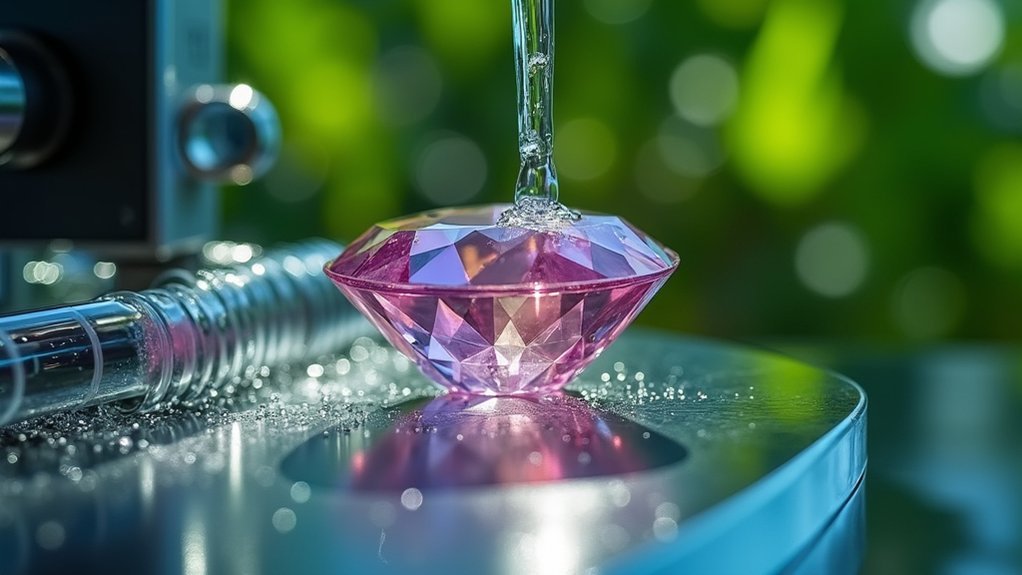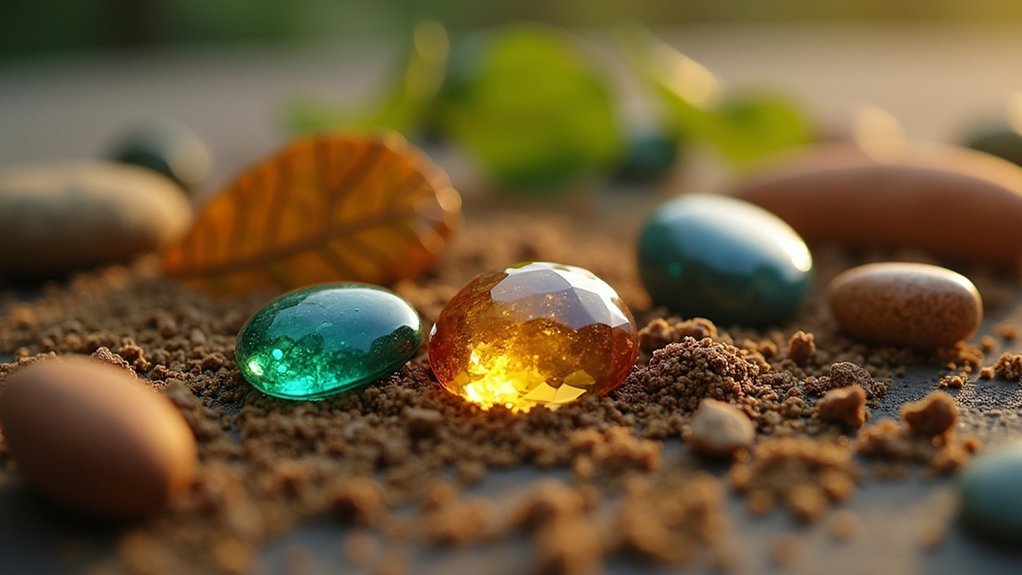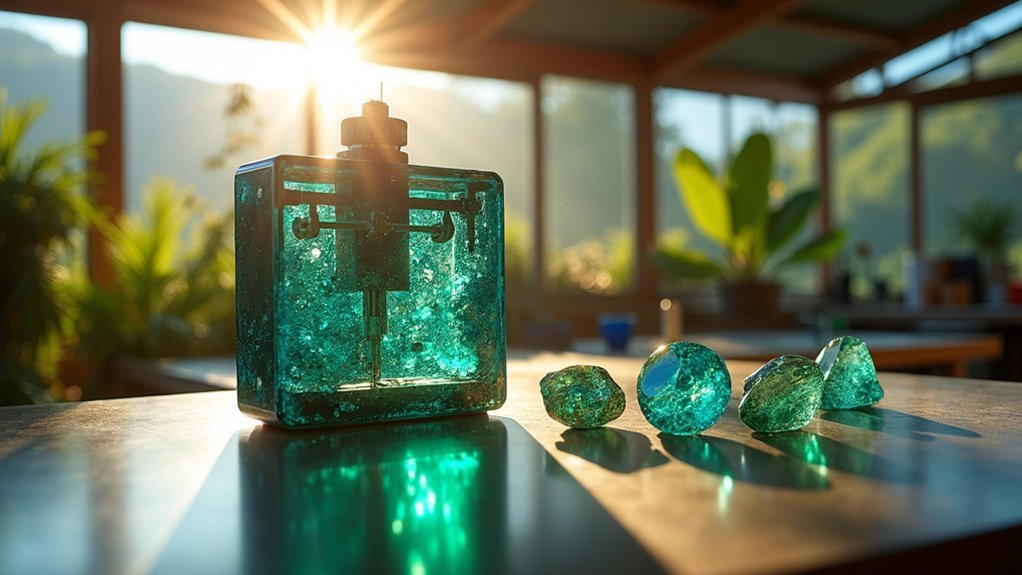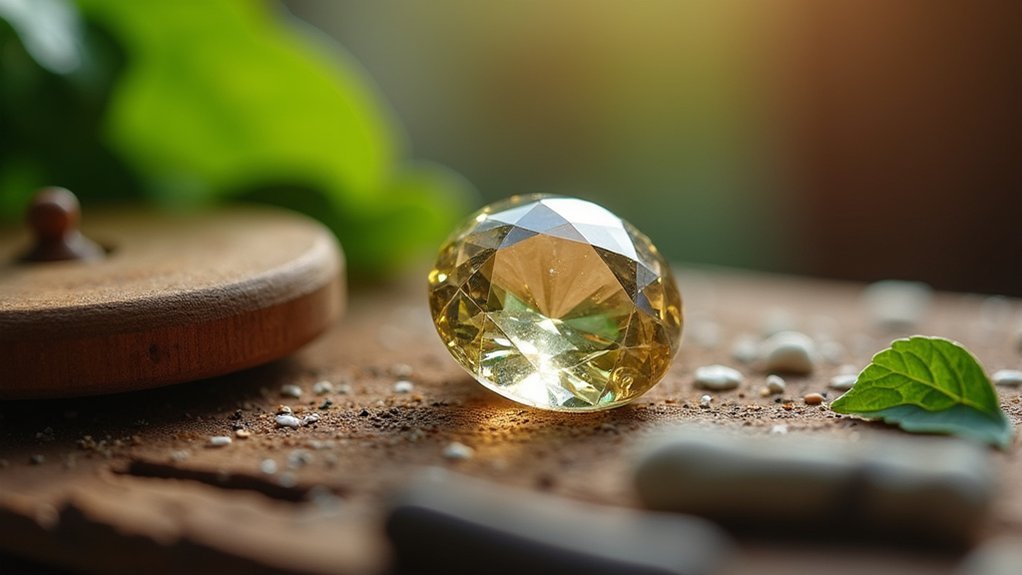You can considerably reduce your environmental footprint with five proven eco-friendly gem cutting methods. Water-efficient closed-loop cooling systems cut consumption by 90%, while traditional hand tools like diamond saws eliminate electricity dependency. Natural abrasives such as garnet and biodegradable plant-based polishing agents replace harmful chemicals. Metal dust recovery systems capture 99% of particles for reuse, and solar-powered equipment reduces operational costs by 30%. These methods reveal sustainable practices that benefit both your craft and the planet.
Water-Efficient Cooling Systems for Precision Cutting

When you’re cutting gemstones, traditional cooling methods can waste thousands of gallons of water during a single project.
Water-efficient cooling systems revolutionize gem cutting by utilizing closed-loop technologies that dramatically reduce water consumption by up to 90%. These advanced systems maintain ideal temperatures for precision cutting while minimizing environmental impact through high-pressure misting and vaporization techniques.
Closed-loop cooling technology slashes gem cutting water usage by 90% while maintaining precision temperatures through advanced misting systems.
You’ll benefit from integrated filtration systems that recycle coolant, ensuring water gets reused rather than discarded after single use.
Smart monitoring technology gives you precise control over water flow and temperature, enhancing performance while reducing your operation’s carbon footprint.
Hand Tool Techniques That Minimize Energy Consumption
Beyond water conservation innovations, hand tool techniques offer another powerful approach to sustainable gem cutting by eliminating electricity dependency entirely.
You’ll find these traditional methods require minimal resources while delivering exceptional results through human-powered precision.
Hand tool techniques provide sustainable options that benefit both environment and craftsmanship:
- Diamond saws and manual grinding wheels reduce energy consumption by relying on your physical effort instead of electricity.
- Traditional bruting and cabochon cutting operate without power, utilizing minimal resources for eco-friendly gem cutting.
- Precise manual control minimizes waste by maximizing gemstone utilization through careful cut selection.
- Natural abrasives and water-based polishing eliminate harmful chemical pollutants from your workspace.
- Training local artisans in these methods supports community economies while promoting sustainable practices.
You’ll discover these techniques offer superior control and environmental responsibility.
Natural Abrasives and Biodegradable Polishing Agents

As environmental consciousness grows within the lapidary community, you’ll discover that natural abrasives and biodegradable polishing agents represent a revolutionary shift toward sustainable gem cutting practices.
You can utilize garnet, emery, and diamond dust as effective natural abrasives that minimize environmental impact compared to synthetic alternatives. These eco-friendly practices reduce your carbon footprint considerably while supporting local economies that harvest these resources sustainably.
Natural abrasives like garnet, emery, and diamond dust offer eco-friendly alternatives that reduce environmental impact while supporting sustainable local economies.
When you incorporate biodegradable polishing agents derived from plant oils and waxes, you’ll eliminate harmful chemical runoff and pollution.
Many artisans now embrace recycled materials, repurposing glass and metal in their polishing techniques. By adopting these natural methods, you’re not only creating beautiful gemstones but also contributing to a more sustainable practice that benefits both the environment and local communities.
Waste Recycling and Material Recovery Methods
While traditional gem cutting methods often discard valuable byproducts as waste, you can now implement extensive recycling systems that transform these materials into profitable resources.
Modern waste recycling technologies enable thorough material recovery throughout your cutting operations.
Advanced eco-friendly approaches include:
- Metal dust capture systems – Recover 99% of particles for creating new tools and jewelry components
- Water recycling networks – Reuse cooling and polishing water, reducing consumption by 80%
- Sustainable abrasives – Utilize polishing compounds made from recycled materials instead of traditional substances
- CAD optimization software – Plan cuts that maximize yield from rough stones while minimizing waste production
- Synthetic diamond production – Transform recovered dust into industrial applications and new gemstones
These material recovery methods greatly reduce environmental impact while maintaining profitability.
Solar-Powered Lapidary Equipment and Renewable Energy Solutions

Building on these waste reduction strategies, you can further minimize your environmental footprint by powering your lapidary equipment with renewable energy sources.
Solar-powered lapidary equipment harnesses photovoltaic panels to reduce fossil fuel dependence and lower carbon emissions during your gem cutting operations. You’ll find that integrating renewable energy solutions like wind and hydroelectric power creates more sustainable workshops while decreasing operational costs by up to 30% over time.
These systems offer additional benefits beyond environmental impact. Your solar-powered tools operate more quietly than traditional equipment, minimizing noise pollution in your workspace.
Frequently Asked Questions
What Is the Best Way to Cut Gemstones?
You’ll get best results using diamond saws and faceting machines for precision cuts. Utilize CAD software to optimize designs, minimizing waste. Water-cooled diamond blades reduce dust while laser cutting enhances accuracy and limits energy consumption effectively.
What Is the Difference Between Lapidary and Gem Cutting?
You’ll find lapidary’s a broader art encompassing all gemstone shaping techniques, while gem cutting specifically focuses on faceting stones for maximum brilliance. Lapidary includes cabochons and tumbling, but gem cutting emphasizes precise facet arrangements.
Which Gemstone Cut Is Best?
You can’t pick a single “best” cut since it depends on your gemstone type and personal preferences. Round brilliant cuts maximize sparkle, while step cuts showcase clarity and color beautifully.
What Gemstone Does Not Lose Value?
You’ll find diamonds, sapphires, and emeralds don’t lose value over time. These gemstones retain worth due to high demand and limited supply. Top-quality stones with excellent cuts often appreciate considerably beyond their original purchase prices.
In Summary
You’ve now discovered how to transform your gem cutting practice into an environmentally responsible craft. By implementing water-efficient cooling, mastering hand tool techniques, choosing natural abrasives, recycling waste materials, and harnessing solar power, you’re reducing your environmental footprint while maintaining precision. These methods won’t just protect the planet—they’ll also lower your operating costs and connect you more deeply with traditional lapidary artistry. Start incorporating these sustainable approaches today.





Leave a Reply